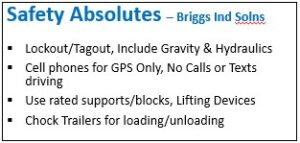At the American Society for Safety Professionals annual PDC meeting in DFW this April, one presentation really stood out for me. It was presented by John Goodpaster, CSP, who is the Director of EHS at Briggs Industrial Solutions. The company primarily services material handling equipment. Their business is primarily conducted by solo field workers. They have 1,000 employees who utilize 650 vehicles across 5 states in the South & Southwest. Briggs is an employee-owned company.
Briggs failed in nurturing an effective safety program for years and from 2015-2018 their safety record hit rock bottom, with lots of injuries - and 4 deaths. The company was also losing a stream of clients over their lack of safety performance. John shared a story of how the company was able to turn this situation around and build effective safety processes and an on-going safety culture in the company.
These are some of the steps the company took that led to this major turnaround:
Leadership Commitment to Lead and Support Safety Efforts:
Management engaged a safety professional and agreed to go full into a safety journey.
Establish Safety Absolutes that Relate to Key Risks:
They reviewed the injuries and circumstances that they occurred in. They decided to initially establish some “Safety Absolutes” for the company (their Cardinal Rules). These were not global mission statements, rather, they were specific safety must-dos. These “safety absolutes” were printed on cards that were shared with every employee.

Research and Share Practical Best Practices Relating to the Safety Absolutes:
These “absolutes” caused discussion and evaluation at every corner of the company. They found that the company had never fully researched and created packaged communications and training on many parts of the absolutes. As a result, the company involved workers in researching best practices in “cribbing large vehicles” then created written guidance for all workers. For those, like me, that are not very familiar with cribbing, it normally involves building heavy wooden base structures to support heavy construction equipment when the equipment is in use at construction sites https://www.altec.com/cribbing-and-blocking-protect-yourself/#:~:text=Proper%20cribbing%20and%20blocking%20helps,height%20than%20blocking%20can%20provide.
Build in a Safety Moment into every Meeting:
The company decided that any time anyone in the company called a meeting (whether live or zoom), they would ensure that someone would share a “safety moment” at the beginning of the meeting -prior to discussing the meeting topic. This usually involved discussing a safety tip or reminder that would be relevant for those attending (lasting 1-2 minutes, accompanied by 1-2 slides –if slides were used at the meeting)
Establish and Track Leading Indicators for Safety:
The management team selected a few items to track proactive efforts in safety. These included the following: a) attending appropriate safety training (with knowledge checks), b) having an active safety committee, and c) Increasing % of trucks with telematics, and discussing the telematics driving data with each worker. (For those not familiar, telematics is a technology that gives a company the ability to remotely track and monitor vehicles).
Coach workers on Safety Processes:
With the new safety information and expectations, workers needed coaching to fully absorb and apply safety basics in their work. For example, a structured system was established to help managers, know when an employee needed more attention and coaching on their driving practices (based on their telemetric data). If driving data scores below 80%, the manager would call a meeting with the individual. He/she would coach them to leaving more space between their vehicle and the one in front of them – which will help reduce their excessive braking scores. They would ask them to use cruise control at the speed limit when on highways, etc. If telematics data scores popped below 80% during the next 4-month process, a phased disciplinary process was started.
Begin a Program where Employees are Motivated to Report Near Misses:
The company began rewarding employees for reporting near misses by donating $5 to the selected charity of the quarter for each report/suggestion. They did not complain about the quality of the reports, they called the originator to clearly understand each one (so the bogus ones stopped coming). They followed up with corrective actions and communicated progress.
Establish Recognition for Safety Performers:
The company began including small communication recognitions (including the following: safe driver, near miss champion, and branch with best safety activity).
Conduct Safety Stand-down when a Safety Leading Indicator is Off-Track:
The company occasionally has the need to “shock-the-system” to keep things on track. They do this by shutting all work at every site for a meeting on a specific topic all on the same day. For instance, they did this once when attendance at safety training dropped off. This dramatic stand-down action got the word out fast – The company does not tolerate people skipping safety meetings.
Conclusion:
After all the programs and activities during the last 6 years, every team member in the company will tell you that Safety is a key part of the company’s DNA now. The company has not experienced deaths in years and injury occurrences and severity are way down (below industry norms) since the Safety Excellence program was started. The determined and steadfast efforts of this leadership team can be an inspiration for all company leaders who are currently struggling to bring safety under control.
These are the key steps the company took that led to this major turnaround:
Leadership Commitment to Lead and Support Safety Efforts
Establish and Communicate Safety Absolutes that Relate to Key Risks
Research and Share Practical Best Practices Relating to the Safety Absolutes
Build in a Safety Moment into every Company Meeting
Establish and Track Leading Indicators for Safety
Coach workers on Safety Processes
Begin a Program where Employees are Motivated to Report Near Misses
Establish Recognition for Safety Performers
Conduct Safety Stand-down when a Safety Leading Indicator is Off-Track
